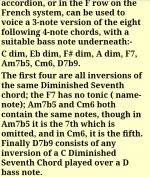craigd
Active member
My head is spinning a bit from reading up on this. I am considering a very nice accordion, but feel I will miss the diminished row. I have read that the 7ths on this system will do for diminished of the next row up because they omit the fundamental instead of the 5th (which regular stradella omit). I see how this provides the missing diminished chord, but doesn't this also limit the flexibility of the seventh chord (for building 9ths etc)? And how useful is the minor 3rd counterbass row?

